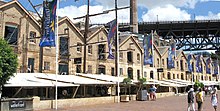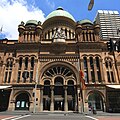Hawkesbury sandstone


The Hawkesbury sandstone (English: Hawkesbury Sandstone ) forms both a stratigraphic formation in Australia and a name for a type of sandstone in the region of Sydney in New South Wales . This rock was formed in a freshwater lake in the Triassic 200 million years ago. In Sydney this sandstone is also called Sydney Sandstone . Hawkesbury sandstone is named after the Hawkesbury River , which flows north of Sydney.
geology
This sandstone is located in the Sydney Basin , which was formed from sediment and sedimentary rocks 290–200 million years ago as part of the larger sedimentary basin , the Sydney - Gunnedah -Bowen Basin. The Sydney Basin extends from Newcastle in the north to Durras Lake on Batemans Bay in the south. From Durras Lake it extends to Ulan near Mudgee , and west to the Blue Mountains . The northern border runs along the Liverpool Range to Muswellbrook. Lava partially entered the fissures of the sandstone layers and solidified into lava rock. The layers of Hawkesbury sandstone are up to 200 meters thick .
It is a freshwater sandstone.
Rock description
The Hawkesbury sandstone is yellow to brown in color and fine to medium grained. The quartz content is different depending on the rock layer, it can be up to 95 percent, feldspar hardly occurs and up to 10 percent lime and clay were found as binding agents in this rock. Iron oxides (about 1 to 3%) color the rock and, when it is sawn up against the bearing, it is different in color in layers depending on the concentration of the iron oxide. The various rings are called Liesegang's rings and were probably formed when the sediment was not yet completely solid, water could still flow through the minerals and the iron oxides were taken with it. The Hawkesbury sandstone contains lenticular and larger clay deposits and layers. Petrified plants, fish and amphibious animals can be found in the clay layers .
Type sandstone
The Hawkesbury sandstone is very weather-resistant with a high quartz content . The Sydney rock engravings in Ku-ring-gai-Chase National Park are thousands of years old and have been preserved to this day. This is due to the fact that this sandstone has a high quartz content and is therefore highly wear-resistant.
use
Sydney is built on the layers of Hawkesbury sandstone and when the Sydney Harbor Tunnel was built , the sandstone layer had to be drilled through.
Many buildings from the Victorian period in Sydney are made of Hawkesbury sandstone, such as the City Town Hall, the Queen Victoria Building , the University of Sydney and today's Radisson Plaza Hotel Sydney , which was once a bank building.
In Sydney, from 1790 to 1890, it was mainly built with this sandstone, which was quarried in the immediate vicinity of the building to be built. Examples of this work can still be seen at The Rocks in Sydney today . Not only were the first Sydney houses built there, but the building blocks used for them were also broken. The historic quarries that were opened in the immediate vicinity of the houses were given names by the convicts depending on how the work was done there, for example hell hole , purgatory and paradise . The highest quality sandstone was quarried in the “Paradise” quarry. From 1850 to the 1900s, the blocks for the most important buildings in Sydney were broken into about 50 quarries in the Pyrmont district two kilometers away . As of 1870, 300 stonecutters and stone cutters are said to have been employed in the stone quarries and building construction in Sydney.
In the 1950s, this sandstone was still popular with architects and builders, both in house and church construction, but also in garden design. In the 1960s and 1970s, numerous houses from this sandstone were demolished. After that, the population began to think about monument protection and attempts were made to preserve these buildings or to use them. This sandstone is still processed today. It enjoys a certain demand because of its interesting texture and is quarried in some quarries near Sydney.
Web links
- Sydney Basin - Geological Overview on dpi.nsw.gov.au
- Illustrations of the textures of Hawkesbury sandstones
- Illustrations of outcrops of the Hawkesbury sandstone
- Use of sandstone around Sydney
Individual evidence
- ^ Sydney Basin at australianmuseum.net.au , accessed January 24, 2010
- ↑ P. Beyless, FC Loucuna, JC Standard: dickites in the Hawkesbury Sandstone of the Sydney Basin, Australia. In: American Mineralogist. Vol. 50, March-April 1965 ( PDF , accessed January 24, 2010).
- ↑ Description on dpi.nsw.gov.au , accessed on January 24, 2010
- ^ Peter NW Verhoef: Abrasivity of Hawkesbury Sandstone (Sydney, Australia) in relation to rock dredging . In: Quarterly Journal of Engineering Geology and Hydrogeology . tape 26 , no. 1 , February 1993, p. 5–17 , doi : 10.1144 / GSL.QJEG.1993.026.01.02 .
- ↑ Sydney Daily Herold v. July 4, 1954 , accessed January 24, 2010
- ^ Hawkesbury Sandstone Quarry





